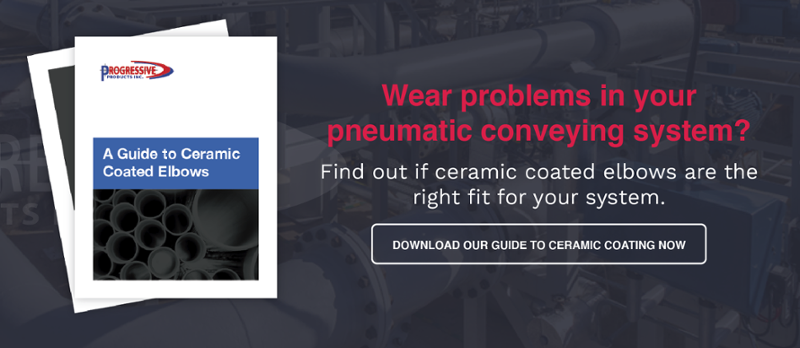Several factors can cause pressure loss in pneumatic conveying, from an incorrect feed rate to moisture in the pipelines. The effects are line blockages, expensive periods of downtime, and high operating costs. Continue reading for five things you can do to minimize loss of pressure in your pneumatic conveying system.
What Causes Pressure Loss in a Pneumatic Conveying System?
Pressure loss in a pneumatic conveying system can be caused by a number of variables. Identifying the root cause of a loss in pressure is imperative in knowing how to properly deal with the problem.
1. Feeding the pipeline incorrectly
Conveying lines in pneumatic systems must be fed at the correct rate in order to avoid blockages and to keep the system running efficiently. If conveying lines are overfed, for example, there won’t be enough pressure to convey the material, resulting in a loss of pressure and a reduced conveying capacity.
2. Air flow and air velocity
With insufficient air flow, pneumatic conveying systems won’t be able to convey products through the pipelines, leading to pressure losses and line blockages. The same can happen if the air velocity is too low at the product pick-up point, reducing the amount of force needed to carry the product.
3. Air leaks
Air leaks in pipelines also cause pressure loss in pneumatic conveying systems. These often occur at pipe joints as a result of worn-out gaskets, loose compression couplings, or if there are any holes. Air leaks reduce the air pressure in the conveying lines, forcing the system to work ten times harder to provide the same amount of power.
4. Air moisture
If moisture enters your pneumatic conveying system, it can cause the material particles to stick to the walls of the pipelines. They can quickly accumulate here, especially if the moisture is carried to other areas of the conveying lines. When this happens, the build-up of material can block the air flow and cause pressure loss in the system.
What Happens When a Pneumatic Conveying System Loses Pressure?
One of the biggest effects of pressure loss in a pneumatic conveying system are line blockages. When there is pressure loss, there isn’t enough air flow or force to convey the material through the pipelines. This can result in the material accumulating in the lines and getting stuck. A blocked pipeline can result in a number of problems:
- Clearing it will require a period of downtime
- Downtime leads to a loss of production and a loss of money
- The incurred maintenance costs can be expensive
The effects of pressure loss in pneumatic conveying can also contribute to high operating costs, a huge proportion of which is consumed by the air movers. If there is a loss in pressure, the required airflow rate and air velocity will increase, putting a greater strain on the air movers and causing them to consume more power.
5 Ways to Minimize Loss in Pressure
If you want to optimize the performance of your pneumatic conveying system by minimizing pressure loss, you should begin with checking all the main conveying parameters, such as the air mass flow rate, total pressure drop, pick-up velocity, feed rate, and so on.
You can then make small adjustments to see which factors, if any, are affecting the performance of your system. There are also a number of other things you can try:
1. Calculate the pressure drop
One of the biggest challenges in pneumatic conveying is calculating the pressure drop over the length of the conveying lines. Given that there’s a pressure gradient across pneumatic conveying systems, it’s important to properly calculate the pressure drop according to the dynamics of your specific system. This will minimize pressure loss by ensuring that the pick-up velocity is high enough.
For example, while one end of your conveying system may have an air velocity of 4,000 ft/min, the other end could be at 9,000 ft/min. You need to account for this pressure drop, otherwise there will be insufficient pick-up velocity to carry the material through the conveying lines.
Factors to consider when calculating the pressure drop through your system include:
- The length of the conveying lines
- The layout of the conveying lines
- The number, position, and size of bends or elbows
- The type of bends (e.g. short, long radius, dead-end tee, or vortex elbow)
- The product density and particle size
One proposed method of calculating pressure loss in pneumatic conveying is using Bernoulli’s equation, which is based on the principle that: “Within a horizontal flow of fluid, points of higher fluid speed will have less pressure than points of slower fluid speed.”
2. Consider minimum air velocities
Different products have different conveying behaviors, particularly when it comes to minimum conveying air velocities and the associated pressure drops. One way to minimize loss in pressure is to adjust the air velocity and, in turn, the air flow rate according to the material you’re conveying.
For example, the influence of material type on minimum air velocities can be seen in the case of fine powdered materials versus coarse materials:
- Fine powdered materials, like cement or fly ash, require a minimum conveying air velocity of approximately 10-12 m/s
- Coarse materials, like sand or granulated sugar, require a minimum conveying air velocity of approximately 13-16 m/s
Studies have also shown that an increase in pressure loss in pneumatic conveying systems corresponds to an increase of the solid mass flow rate, particle size, and particle density, such as the case of coarse materials requiring higher minimum air velocities.
An increase in velocity causes the molecules of a material to collide more. This translates as a greater loss of kinetic energy and, as a result, a greater pressure drop. For this reason, it’s important to offset any changes made to the air velocity with corresponding changes to the air flow.
3. Ensure conveying lines are fed correctly
Just as different materials have different minimum air velocities, so do they have different feed rate requirements. It’s crucial to change the material feed rate accordingly if you want to minimize pressure loss because it has a big influence on air flow.
For example, the design features that meet material A’s flow properties won’t necessarily work for material B. This could result in you either underusing the pipeline, making it more expensive and inefficient to run, or blocking the pipeline, causing pressure loss.
You should also factor in the distance you’re conveying materials over when determining the ideal feed rate. This is because the travel distance of a material is directly proportional to the air required to convey it.
4. Check for air leaks
As we mentioned earlier, air leaks are a major contributor to a loss in pressure. To minimize these as much as possible, you should regularly check for them. Luckily, if there’s an air leak in your lines, it should be easy to detect because you’ll be able to hear or feel it.
To prevent air leaks from happening in the first place, rather than simply waiting for them to occur, you should regularly inspect the components in your system, namely the:
- Morris couplings
- Tri-clover clamps
- Airlock flanges
- Pressure or vacuum gauge ports
- Blower silencers
- Blower flanges
- Butterfly valves (bypass in blower)
- In-line diverter valves
5. Consult an Expert
If your system is exhibiting the effects of pressure loss and you’re unsure what else to do, contact someone who does. They will be able to conduct a thorough inspection of your system and will advise you on the best course of action.
Regularly maintaining your pneumatic conveying system is the best bulwark against system faults like pressure loss. Always ensure that your system and its components are periodically checked for faults in order to avoid expensive repairs and unproductive periods of downtime.



